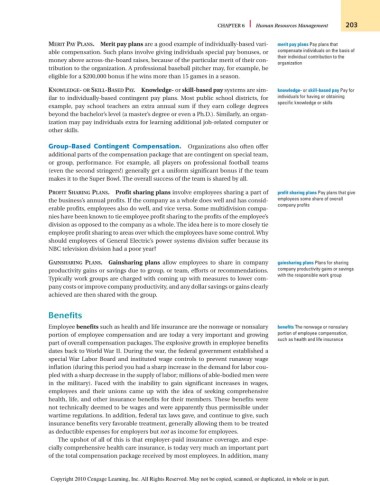Page 229 - Introduction to Business
P. 229
CHAPTER 6 Human Resources Management 203
MERIT PAY PLANS. Merit pay plans are a good example of individually-based vari- merit pay plans Pay plans that
able compensation. Such plans involve giving individuals special pay bonuses, or compensate individuals on the basis of
their individual contribution to the
money above across-the-board raises, because of the particular merit of their con-
organization
tribution to the organization. A professional baseball pitcher may, for example, be
eligible for a $200,000 bonus if he wins more than 15 games in a season.
KNOWLEDGE- OR SKILL-BASED PAY. Knowledge- or skill-based pay systems are sim- knowledge- or skill-based pay Pay for
ilar to individually-based contingent pay plans. Most public school districts, for individuals for having or obtaining
specific knowledge or skills
example, pay school teachers an extra annual sum if they earn college degrees
beyond the bachelor’s level (a master’s degree or even a Ph.D.). Similarly, an organ-
ization may pay individuals extra for learning additional job-related computer or
other skills.
Group-Based Contingent Compensation. Organizations also often offer
additional parts of the compensation package that are contingent on special team,
or group, performance. For example, all players on professional football teams
(even the second stringers!) generally get a uniform significant bonus if the team
makes it to the Super Bowl. The overall success of the team is shared by all.
PROFIT SHARING PLANS. Profit sharing plans involve employees sharing a part of profit sharing plans Pay plans that give
the business’s annual profits. If the company as a whole does well and has consid- employees some share of overall
company profits
erable profits, employees also do well, and vice versa. Some multidivision compa-
nies have been known to tie employee profit sharing to the profits of the employee’s
division as opposed to the company as a whole. The idea here is to more closely tie
employee profit sharing to areas over which the employees have some control. Why
should employees of General Electric’s power systems division suffer because its
NBC television division had a poor year?
GAINSHARING PLANS. Gainsharing plans allow employees to share in company gainsharing plans Plans for sharing
productivity gains or savings due to group, or team, efforts or recommendations. company productivity gains or savings
with the responsible work group
Typically work groups are charged with coming up with measures to lower com-
pany costs or improve company productivity, and any dollar savings or gains clearly
achieved are then shared with the group.
Benefits
Employee benefits such as health and life insurance are the nonwage or nonsalary benefits The nonwage or nonsalary
portion of employee compensation and are today a very important and growing portion of employee compensation,
such as health and life insurance
part of overall compensation packages. The explosive growth in employee benefits
dates back to World War II. During the war, the federal government established a
special War Labor Board and instituted wage controls to prevent runaway wage
inflation (during this period you had a sharp increase in the demand for labor cou-
pled with a sharp decrease in the supply of labor; millions of able-bodied men were
in the military). Faced with the inability to gain significant increases in wages,
employees and their unions came up with the idea of seeking comprehensive
health, life, and other insurance benefits for their members. These benefits were
not technically deemed to be wages and were apparently thus permissible under
wartime regulations. In addition, federal tax laws gave, and continue to give, such
insurance benefits very favorable treatment, generally allowing them to be treated
as deductible expenses for employers but not as income for employees.
The upshot of all of this is that employer-paid insurance coverage, and espe-
cially comprehensive health care insurance, is today very much an important part
of the total compensation package received by most employees. In addition, many
Copyright 2010 Cengage Learning, Inc. All Rights Reserved. May not be copied, scanned, or duplicated, in whole or in part.

